Somnath Jyotirling
The Somnath Jyotirling Temple, also called Somanatha temple or Deo Patan, is a Hindu temple located in Prabhas Patan, Veraval in Gujarat, India. Somnath Temple is the first of the 12 sacred Jyotirlingas which is dedicated to Lord Shiva. Somnath is a form of Lord Shiva that translates to “Lord of the Moon.”
The Somnath Jyotirling Temple is located in Prabhas Patan, close to Veraval Port in Saurashtra, Gujarat. It is also known as “The Eternal Shrine” because the temple has been looted and destroyed six times. However, it was magnificently rebuilt every time after that.
It is unknown when the first version of the Somnath temple was built, with estimates ranging from the early 1st millennium to around the 9th century CE. The temple was rebuilt several times in the past after being destroyed by multiple Muslim invaders and rulers, most notably an attack by Mahmud Ghazni in the 11th century.
Story Behind Somnath Jyotirling Temple
Ancient Indian traditions associate Somnath with the release of Chandra (Moon God) from the curse of his father-in-law Daksha Prajapati. According to legends, Moon was married to twenty-seven Daksha daughters. He did, however, prefer Rohini over the other queens. The Moon was cursed by the enraged Daksha, and it lost its ability to emit light. Moon went to the Prabhas Teerth on the advice of Prajapita Brahma and worshipped Bhagvan Shiva.

Moon’s great penance and devotion pleased Bhagavan Shiva, who blessed him and freed him from the curse of darkness. According to Pauranic traditions, Moon built a golden temple, followed by Ravana’s silver temple, and Bhagvan Shree Krishna is said to have built Somnath temple out of Sandalwood.
History of Somnath Jyotirling Temple
According to legend, the moon god Somraj initially constructed a gold temple in Somnath; Ravana used silver, Krishna used wood, and Bhimdev used stone to rebuild this. Somnath’s first temple is thought to have been built 2,000 years ago. In 649 AD, King Maitre of Vallabhini built and renovated a second temple in its place. In 725, the old ruler of Sindh attacked and destroyed the temple with his army. Pratishtha King Nag Bhatt II used red stone (sandstone) to construct the temple for the third time in 815.
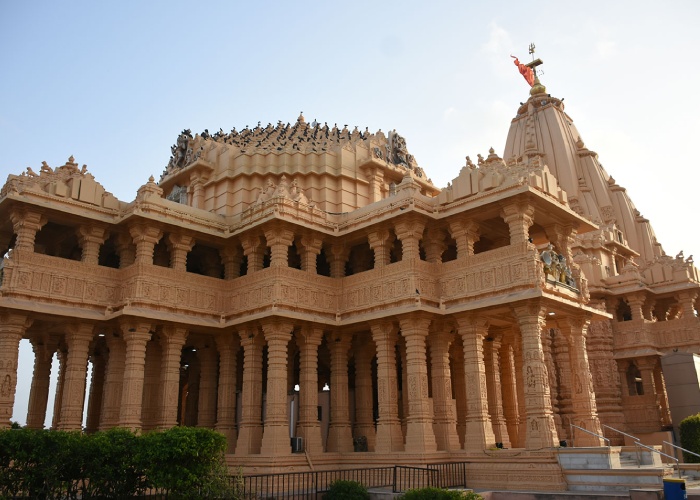
In 1026, Mahmud Ghazni looted the valuable jewels and property of the Somnath temple. Following the looting, slaughtering, and burning of the temple, which resulted in its destruction, Solanki Raja Bhimdev, Parmar King of Malwa, built the fourth temple between 1026 and 1042. Somnath was destroyed when the Delhi Sultanate occupied Gujarat in 1299. It was destroyed yet again in 1394. In 1706 the Mughal emperor Aurangzeb destroyed the temple once more. The temple was not rebuilt again until 1950.
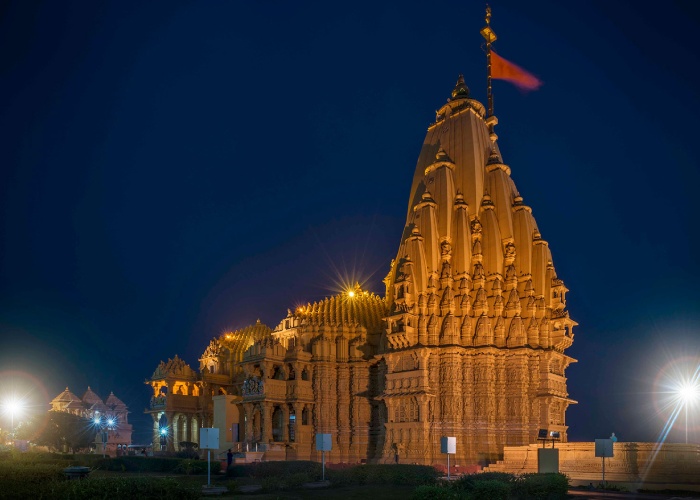
Reconstruction – On November 13, 1947, India’s Iron Man and First Home Minister Sardar Vallabhbhai Patel promised to rebuild the temple. Today’s Somnath Temple is built on its original seventh-place location. When the temple was rebuilt on December 1, 1995, it was dedicated to the country by Indian President Dr. Shankar Dayal Sharma. When Dr. Rajendra Prasad proposed purifying Jyotirling in 1951, he said, “This temple of Somnath is a symbol of victory over construction on destruction.” The temple was built by the Shri Somnath Trust, which is now monitoring it.
Somnath Temple Somnath Jyotirling Temple
On November 13, 1947, India’s Iron Man and First Home Minister Sardar Vallabhbhai Patel promised to rebuild the temple. Today’s Somnath Temple is built on its original seventh-place location. When the temple was rebuilt on December 1, 1995, it was dedicated to the country by Indian President Dr. Shankar Dayal Sharma. When Dr. Rajendra Prasad proposed purifying Jyotirling in 1951, he said, “This temple of Somnath is a symbol of victory over construction on destruction.” The temple was built by the Shri Somnath Trust, which is now monitoring it.

Interior – A Sabha Mandap, or assembly hall, a Nrityamandap, a Garbha Griha, and the Jyotirlingam are among the interior features of the temple. The ceiling is covered in beautiful watercolour paintings and is made of loadstone. There is a legend that the temple’s interior was once lavishly decorated with precious stones and jewels. However, in order to seize all of these glittering riches, invaders and attackers periodically attacked the temple.
Facts about Somnath Jyotirling Temple
- The Somnath Jyotirling Temple is located in Prabhas Patan, Saurashtra, West Gujarat, India, at the Triveni Sangam, which is the confluence of the mythological Saraswati, Hiranya, and Kapila rivers.
- The Somnath Jyotirling Temple was rebuilt several times in the past after being destroyed by multiple Muslim invaders and rulers, most notably an attack by Mahmud Ghazni in the 11th century.
- After receiving Mahatma Gandhi’s approval for reconstruction, the modern Somnath temple was begun under the orders of India’s first Deputy Prime Minister, Vallabhbhai Patel.
- Somnath Jyotirling Temple is first among the twelve Aadi Jyotirlingas of India. It is located at a strategic location on the western coast of India.
- The blessings of Bhagvan Somnath are said to have freed the Moon God from the curse of his father-in-law Daksha Prajapati.
- Visiting this ancient and divine site during Mahashivratri would be the ultimate treat for any devotee!
- Devotees believe that a visit to this temple will wash away their sins.
- Prabhasa Khanda, a chapter in the Skanda Purana, mentions this temple. The Rig Veda and the Bhagavat both mention it.
- The temple is constructed in such a way that there is no land in a straight line to its south until Antarctica. Since 7 AD, this has been inscribed on one of the pillars. As a result, it is a sea-protected site.
Famous Festivals In Somnath Jyotirling Temple
- Mahashivaratri: The Maha Shivaratri festival is a grand event at Somnath Jyotirling Temple, as it is at all important Shiva temples. It is the main festival in town. Every year, millions of devotees flock to this town to catch a glimpse of the Lord on this auspicious day, which falls in February/March.
- Ganesh Chaturthi: Dedicated to Lord Ganesh, this festival is celebrated in August / September
- Durga Puja. (Winter) – Devotees celebrate Navaratri at this temple in the month of Ashwin (Sep-Oct) as well as celebrate the triumph of the Goddess Durga over the buffalo demon (Mahishasura).
- Navaratri. (Summer) – They celebrate other Navaratri in the fortnight of the Chaitra (March-April). Every nine days they worship Navadurga (nine Durgas).
How to Reach Somnath Jyotirling Temple
By Air: The Somnath Jyotirling Temple is About 130 km southeast of the Porbandar airport and about 85 km west of the Diu airport.
By Rail: It is about 7 Km southeast of the Veraval railway junction.
By Road: The city is well connected, you can reach there with cabs /taxis or buses. The quickest way to travel by road is via NH27 and NH47. The road trip from Ahmedabad to Somnath temple takes approximately 7 hours.
Also Read – Mallikarjuna Jyotirling
Location
Facilities
- Drinking Water
- Pooja Item Shops
- Prasad Shops
- Restaurants Nearby
- Resting Room
Frequently Asked Questions
Aarti Timings : Morning = 7:00 AM, 12:00 Noon, 7:00 PM.
Light And Sound Show Timing = 8:00 PM To 9:00 PM.
(Except in the Monsoon / Rainy Season).
Nearest Airport : DIU – 85 Kms. ,
Rajkot – 200 Kms,
Ahmedabad – 390 Km.
Nearest Railway Station – Somnath – 0.5 Km, Veraval – 7 Km.


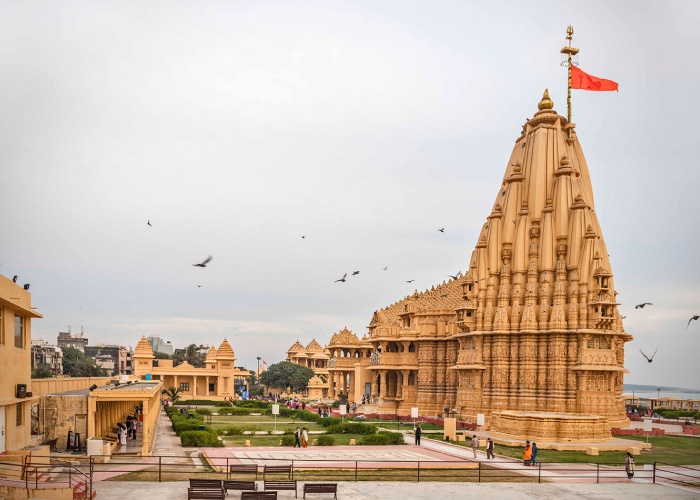







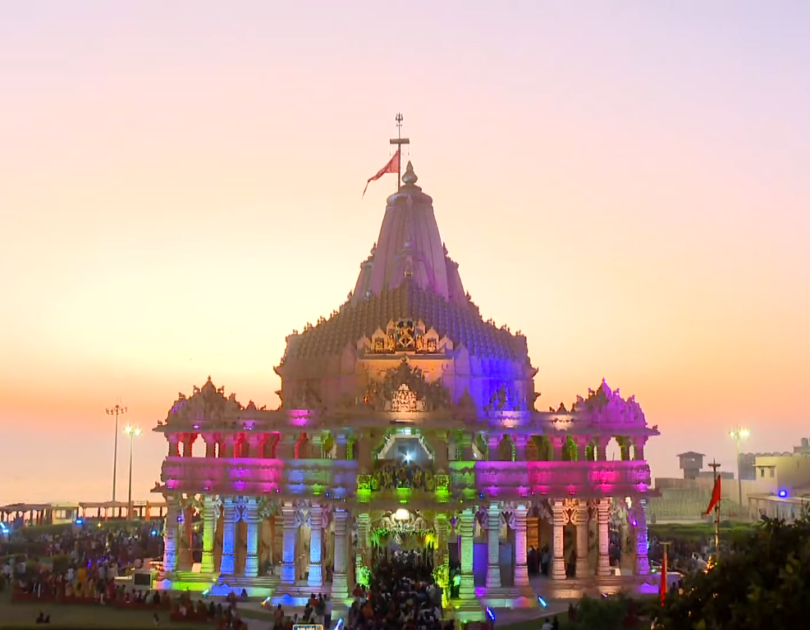
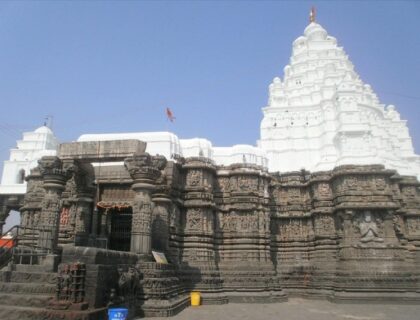
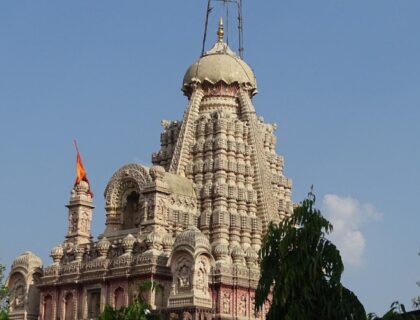
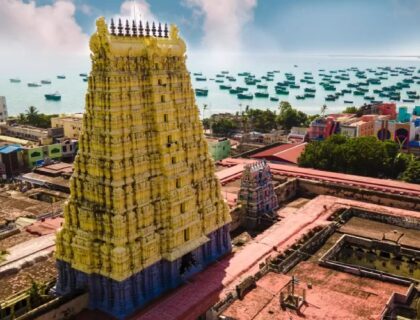
1
Reviewed on March 21, 2023